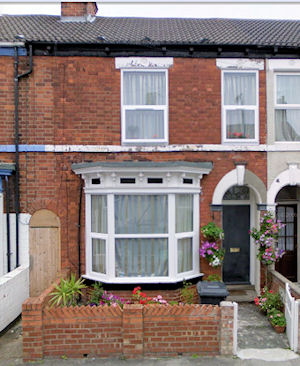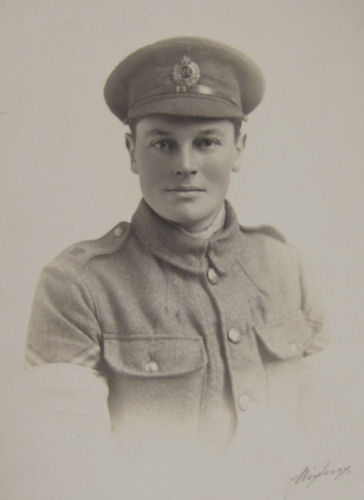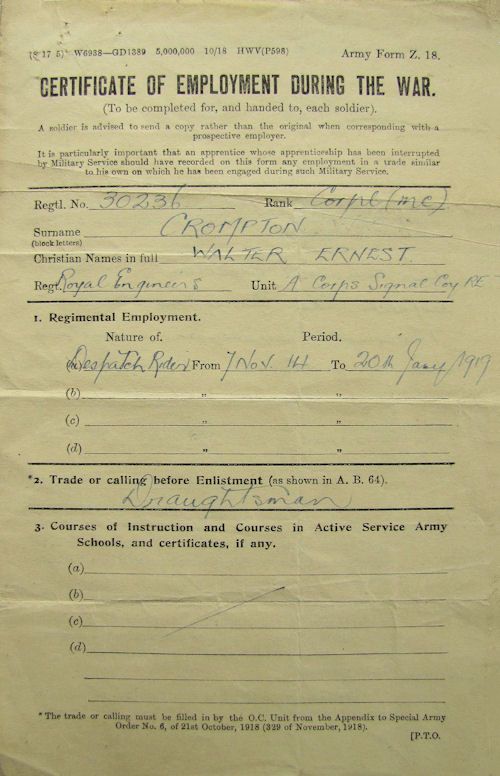| Right: 15 Malm Street, Hull |  |
1805 Info 2e for John Crompton |
Walter Ernest, the tenth child of Thomas and Margaret
The birth of CROMPTON At Lowthorpe, March 13th, the wife of Thomas Crompton, farmer, of a son
Source: Driffield and Wolds Genealogy - Birth Announcements from the Driffield Times, March 22, 1884
Walter Ernest was born in the first quarter of 1884 (GRO ref: Driffield 9d 330). The 1901 and 1911 census shows the progress of his engineering trade.
1901 Census Sun/Mon 31st March/1st April 1901
Source: FHL Film PRO Ref RG13
Piece: 4493; Folio: 140; Page: 6
Dwelling: 32 Barley Street
Place: Sculcoates, Kingston upon Hull, York ER, England
Name Rel Mar Age Occupation Status Birthplace
Walter E Crompton Board U 17 Engineers Apprentice Worker Yorks, Lowthorpe
1911 Census: Sun/Mon 2nd April/3rd April 1911
Source TNA Ref: RG14 PN28792
Reg. Gen. Ref: RG78 PN1652 RegDist: 522 SubDist: 2 En.Dist: 23 Sched: 28
Dwelling: 15 Malm Street [HU3 2TF]
Place: Hull
Rooms in dwelling, other than scullery, landing, lobby, closet, bathroom: 7
Years married: 35
Children: Alive none, dead none
Name Rel Mar Age Occupation Status Birthplace
Samuel Oldham Cawthorne Head M 73 Retired newspaper Lincs, Gainsbro'
manager
Mary Cawthorne Wife M 66 Lincs, Carlton
le Moorland
Hilda Cawthorne Dau U 40 Yorks, Hull
Walter Ernest Crompton Board U 27 Engineer's Draughtsman Worker Yorks, Lowthorpe
Marine Engines
| Right: 15 Malm Street, Hull |  |
| Right: 15 Malm Street, Hull |  |
| The photograph on the right shows Walter with his brother John Henry and his mother,
an elderly Margaret Elizabeth at Hall Green Farm, Wakefield, the home of Walter's
brother Charlie. It was taken between John Henry's return from Canada and his sailing
to Australia - 27 April and 31 July 1914. John Henry has marked the back of the
photograph 'My mother, brother Charlie's wife and little girl and brother
Walter'. It is possible that the two brothers took Margaret Elizabeth to Hall
Green Farm.
John Henry, in his soldier's will, left everything to his brother Walter. Does this and the photograph suggest a special bond? Right - left to right: Walter, John Henry Anne Elizabeth, Ruthie and Margaret Elizabeth Source: Diane CARL from Jack's letter to Alex POSTANS 06 September 1915 |
 |
Walter Ernest CROMPTON, the World War One dispatch rider
Walter CROMPTON began training on 07 November 1914. He entered France on 02 January 1915 and served with A Corps Signal Company, Royal Engineers until 20 January 1919. There is no obvious service record available. His service dates suggest Michael Carragher?s observations about the 1914 Dispatch Riding 1 may apply.
|
[In January 1915 the front line settled down to positional trench warfare, after the very
closely fought open warfare of First Ypres.]
The ideal despatch rider (DR) had "native ability ... keenness ... initiative ... readiness to meet an emergency", and was physically robust.1 He should in the first place be fit and in hard training, ready at a moment's notice to undertake any mission that may be given him. He should be a good horseman, a cyclist, and something of a mechanic; be able to find his way by day or night, with the aid of the sun, stars or compass; know the names and ranks of all generals, staff officers and commanders of units; possess a good knowledge of scouting, to enable him to pass safely through hostile territory; and ? perhaps most difficult of all ? be qualified to deliver a verbal message word for word as he receives it.2A good deal to ask, but a good deal was delivered: To ensure good service in this important branch during mobile warfare, men of exceptional intelligence, endurance and courage, and, especially, men possessing initiative of a high order, were required [?]. 3Right: A studio photograph, by Brigham of Scarborough, of Corporal Walter CROMPTON RE in World War 1 |
 |
| Right: 30236 Corporal Walter CROMPTON's medal index card,
which shows he arrived in France on 02 January 1915 as a member of the Royal Engineers
and so qualified for the 1914-15 Star. At the end of hostilities he transferred to the
'Z' Reserves. In December 1918 soldiers being demobilised were first posted to
Class Z. They could return to civilian life but knew they were obliged to return if
necessary. The Z Reserve was abolished on 31 March 1920.
Source: TNA WO 372/5 |
 |
In the evolving war time communication situation Army training pamphlet SS135 (1917 edition) described the role of the motor dispatch rider as being available for use between division and brigade headquarters. Source: Lee John, 'Command and Control in Battle' in Sheffield, Gary and Todman, Dan (Ed) 'Command and Control on the Western Front', Spellmount, Stroud, 2007
 |
[There were two types of DRs. ?Scout Officers? were appointed as
subalterns but "[we] were never under any circumstances to consider [as]
officers", though were more privileged than the corporals of the Signals Service,
Royal Engineers].
Their background was an important factor in what DRs did in 1914 and beyond. [?T]heir background, their enormous class confidence and consequent sense of assurance were to affect the despatch rider's performance. Their initial suspicion of soldiery could not be entirely dispelled in their brief training, which barely lasted a fortnight [in August 1914]. 4 Instead these men discharged their duty out of their sense of duty, not because they were following orders. [?] |
| Above: Walter at Aldershot c.1914 on a 1912 Zenith Gradua 770cc single cylinder JAP Source: Peter COOPER family photograph |
| Above: The dispatch of
HRH Edward, Prince of Wales
2 carried Walter on 02 February 1915 to GHQ St Omer. Note:
From 02 June 1915 First Army Headquarters were located at Chocques not 1st Army Corps Source: Peter COOPER family archive |
| Right: Walter CROMPTON's certificate of identity dated 1919. This
suggests that Walter was discharged from Clipstone, near Newark Nottinghamshire on 28
January 1919. It was franked by a Post Office in South Gosforth, Newcastle on Tyne
between February and April 1919.
This document confirms his regimental number as 30236 and rank of corporal dispatch rider, one of nine motor cyclists, for A Corps Signal Company in the Royal Engineers. At this time his address was 7 Princess Royal Terrace, Scarborough, the family home. |
 |
| Right: Walter CROMPTON's certificate of wartime employment
This shows he enlisted on 7 November 1914 and served until 20 January 1919 and confirms his pre-war 'trade' as a draughtsman and his army unit. |
 |
On 4 November 1922, John Henry CROMPTON's Australian National Memorial Plaque, Memorial Scroll and 'Where the Australians Rest' were sent to Margaret Elizabeth WILLIAMS, at 18 Kingswood Avenue, High West Jesmond, Newcastle-on-Tyne. It is possible that she lived with her son Walter. Walter continued his profession in the shipbuilding company of Swan Hunter, Newcastle.
 |
 |
| Above: Map locating 18 KIngswood Avenue, High West Jesmond
Right: 18 KIngswood Avenue, High West Jesmond |
| Right: Walter CROMPTON in the Civil Defence during World War 2 and showing
his three World War 1 medals
Peter COOPER, Walter's great nephew, recalls taking his mother Ruthie up to Newcastle roundabout 1961 to see Walter, who was a single man working for Swan Hunter, still in the ship building industry. As Walter did not respond to Christmas cards from his nieces, Ruthie and Leila, they presumed he had passed on. Ruthie had, for years, kept in contact with Walter but never got any replies for over 15 years and so presumed he had died. In 1975, when the COOPERS lived Ponteland outside Newcastle, they were notified that Walter had died in a home in Newcastle In his will Walter left his money, the little amount there was, to Leila who by this time had died and it passed down to her nephews Peter and Michael. Peter was also offered a few of Walters possessions, the most notable being an envelope signed by the Prince of Wales - apparently he had been the wartime dispatch rider. Sheila MELLSTROM recalls that in his will Walter's money was left to his nephew Harry and niece Leila. |
 |
1939 England and Wales Register 29 September 1939 Sched no: 223 Dwelling: 23 Jesmond Road West Borough, Newcastl-on-TyneUD or RD: Names Sex D of B Status Personal Occupation Others Shaw Henry R M 12may82 M Motor engineer, driver & salesman Shaw Ethel L F 19nov85 M Unpaid domestic duties Shaw Ethel L F 19mar11 S Typist Crompton Walter E M 13mar84 S Mechanical Engineer Draughtsman PWC512/2986
In 1939 Walter was still single. Royal Mail Post Code finder does not list a 23 Jesmond Road West but it would seem that Jesmond Road West is a terrace of three storey houses, now divided into flats. Walter Ernest died in the first quarter of 1975 (GRO ref: Newcastle Upon Tyne 2 0568).
His death and will
Walter Ernest died on 04 March 1975 at The White Horse, Osborne Road, Jesmond, Newcastle-on- Tyne. Probate, to the value of ?10844, was proved on 04 April 1975. This is equivalent to ?168,700 in 2018. There is no evidence of the presumed pub.
| More information 1 |
| More information 1 cont:- |
| A Divisional Signals Company, to which dispatch riders were attached, comprised of ?five
sections, headquarters [and] Nos 1, 2, 3 and 4. Headquarters and No 1 are attached to the
headquarters staff of the division; 2, 3, and 4 being attached to the first, second and
third brigades respectively.? 11 At this moment it is not possible to match
these divisions to Walter's specific unit.
"[T]he service given by the despatch riders was superb, and though casualties to men and machines were fairly frequent, and the strength of many units was down to a minimum, touch was kept and messages cleared with exemplary promptitude". 12 Yet another professional, with more than seven decades of perspective, is even more forthright: "At no time in this century has signals intelligence affected campaigns more significantly than at the very hour of its birth, in 1914" 13 - when the linchpin of Signals was the despatch rider. Notes:
|
| More information 2 |
HRH Edward, Prince of Wales, later Edward VIII
|
 |
 |
 |
|
| This page was created by Richard Crompton and maintained by Chris Glass |
Version A9 Updated 14 August 2020 |
||